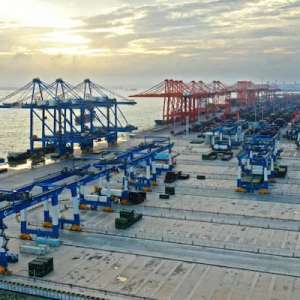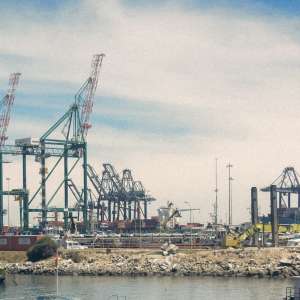The Ultimate Guide to Shipping from Qinzhou to Malaysia
Latest update on 1 August, 2024 by Angelina Pang– Marketing Analyst at FreightAmigo
Qinzhou Ocean Port, situated in the Guangxi Zhuang Autonomous Region of China, has emerged as a crucial hub for international trade and freight transportation. As the economic ties between China and Southeast Asian countries, particularly Malaysia, continue to strengthen, the demand for efficient and reliable freight services from Qinzhou to Malaysia has grown exponentially.
This comprehensive guide aims to provide detailed information on the various aspects of freight transportation from Qinzhou Ocean Port to Malaysia, including shipping routes, logistics options, customs clearance, and best practices for a smooth and successful delivery.
Want to Instantly Compare International Express, Air, Sea, Rail Freight And Truck Logistics Management Solutions To Control Transportation Costs?
Shipping Routes and Transit Times
Qinzhou Ocean Port is strategically located along the Maritime Silk Road, offering direct access to major shipping lanes and connectivity to various ports in Southeast Asia, including those in Malaysia. The most common shipping routes from Qinzhou to Malaysia include:
1. Qinzhou to Port Klang:
- Distance: Approximately 1,500 km
- Transit time: 7-10 days (depending on vessel speed and weather conditions)
2. Qinzhou to Tanjung Pelepas:
- Distance: Approximately 1,700 km
- Transit time: 8-12 days (depending on vessel speed and weather conditions)
3. Qinzhou to Penang:
- Distance: Approximately 1,600 km
- Transit time: 8-11 days (depending on vessel speed and weather conditions)
It’s important to note that transit times can vary depending on factors such as vessel schedules, weather conditions, and any potential delays or disruptions along the route.
Logistics Options and Considerations
When shipping freight from Qinzhou Ocean Port to Malaysia, shippers have several logistics options to choose from, each with its own advantages and considerations:
1. Full Container Load (FCL):
- Suitable for large shipments or when the entire container capacity is required
- Faster transit times and more flexibility in scheduling
- Higher upfront costs but potentially more cost-effective for larger volumes
2. Less-than-Container Load (LCL):
- Suitable for smaller shipments that do not require a full container
- Shared container space with other shippers
- Potentially more cost-effective for smaller volumes, but longer transit times
3. Intermodal Transportation:
- Combination of sea and land transportation (e.g., rail or truck)
- Offers increased flexibility and potential cost savings for longer-distance shipments
- Requires additional coordination and planning between different modes of transportation
When choosing the logistics option, shippers should consider factors such as the size and weight of the freight, delivery timelines, cost, and any specific requirements or restrictions at the origin or destination ports.
Customs Clearance and Documentation
Navigating the customs clearance process is a critical aspect of freight transportation from Qinzhou to Malaysia. Shippers must ensure that all necessary documentation is accurate and complete to avoid delays or additional costs. The key documents required for customs clearance include:
1. Commercial Invoice:
- Detailed description of the goods, including quantity, value, and HS codes
- Signed by the exporter
2. Packing List:
- Detailed list of the contents of each package or container
3. Bill of Lading:
- Contract between the shipper and the carrier for the transportation of goods
4. Certificate of Origin:
- Certifies the country of origin of the goods
5. Import/Export License:
- Depending on the nature of the goods, specific licenses may be required
It’s advisable to work closely with a reputable freight forwarder or customs broker to ensure a smooth customs clearance process and compliance with all relevant regulations.
Freight Rates and Surcharges
The freight rates for shipping from Qinzhou Ocean Port to Malaysia can vary depending on several factors, including:
1. Container Size:
- 20-foot (TEU) or 40-foot (FEU) containers
2. Freight Type:
- Dry cargo, refrigerated cargo, hazardous materials, etc.
3. Shipping Route:
- As mentioned in the “Shipping Routes and Transit Times” section
4. Seasonality and Peak Periods:
- Rates may fluctuate based on supply and demand
In addition to the base freight rate, shippers should also be aware of potential surcharges, such as:
- Fuel Surcharge: Adjusts for fluctuations in fuel prices
- Terminal Handling Charge: Covers the cost of loading and unloading the container
- Documentation Fee: Covers the administrative costs of processing the required documents
It’s recommended to obtain quotes from multiple freight forwarders and compare the overall costs, including any applicable surcharges, to find the most competitive and suitable option for your shipment.
Best Practices and Considerations
To ensure a successful and efficient freight experience from Qinzhou Ocean Port to Malaysia, shippers should consider the following best practices:
1. Early Planning and Booking:
- Reserve container space and book the shipment well in advance to secure favorable rates and availability
2. Cargo Preparation and Packaging:
- Ensure proper packaging and labeling to prevent damage during transit
- Adhere to any specific requirements or regulations for the type of goods being shipped
3. Tracking and Monitoring:
- Utilize real-time tracking services to monitor the status of the shipment
- Communicate regularly with the freight forwarder or carrier to stay informed of any delays or issues
4. Insurance and Risk Management:
- Consider cargo insurance to protect against potential losses or damages during transportation
5. Collaboration with Freight Forwarders:
- Work closely with a reputable and experienced freight forwarder to navigate the logistics and customs clearance processes
By following these best practices, shippers can ensure a smooth and successful freight journey from Qinzhou Ocean Port to Malaysia, minimizing any potential delays, complications, or additional costs.
Conclusion
Qinzhou Ocean Port has emerged as a strategic gateway for freight transportation between China and Southeast Asia, particularly Malaysia. With its well-developed infrastructure, efficient logistics services, and strategic location along the Maritime Silk Road, Qinzhou offers shippers a reliable and cost-effective option for their freight transportation needs.
By understanding the various shipping routes, logistics options, customs clearance requirements, and best practices outlined in this comprehensive guide, shippers can make informed decisions and ensure a seamless freight experience from Qinzhou Ocean Port to Malaysia. As the economic ties between the two regions continue to strengthen, the significance of Qinzhou Ocean Port as a key transportation hub will only continue to grow, making it an essential consideration for businesses engaged in cross-border trade.
If you are looking for logistics experts, please visit FreightAmigo Page
If you have any inquiries on logistics / supply chain, feel free to contact FreightAmigo now:
Chat with us online | Hotline: +852 28121686 | WhatsApp: +852 27467829










































